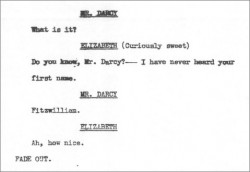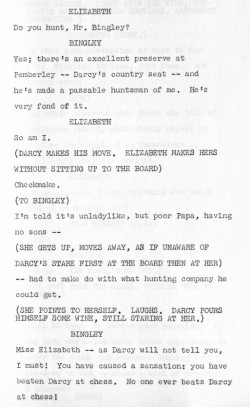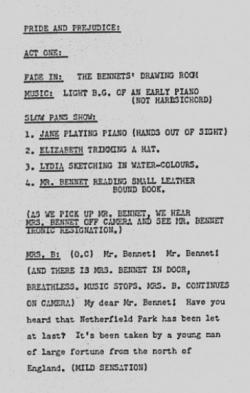Most people considering adaptations of Pride and Prejudice would think of either the 1995 BBC miniseries or the 2005 motion picture. Alternatively, older readers might fall back on memories of the 1980 BBC series or the 1940 movie. They may be surprised to learn that even before that film, Pride and Prejudice had already been televised. Between 1938 and 1967, in a space of just thirty years, ten television programs were made based on the novel. The BBC made the majority, but others were made in North America, Italy, the Netherlands, and Spain.1
It’s disappointing that most of these televised adaptations cannot be seen by anyone ever again: some were performed live in front of the camera and never recorded; others were later discarded. The moment when they were on television was therefore a case of first and last impressions. None of the extant programs from this period has been released, so only via surviving scripts and film archives is it possible to form an impression of them.
It has previously been rather difficult to get the overview straight. Several books, such as The Cambridge Companion to Pride and Prejudice, seem to have simply copied the list out of Sue Parrill’s Jane Austen on Film and Television (2002), thereby missing several adaptations that have been discovered since Parrill’s work. All of the now-known versions were added to the Internet Movie Database around 2008, so their existence has been established.
Furthermore, some articles overlook the existence of the 1938 BBC broadcast, the very first televised adaptation, or they include the 1949 broadcast but not the other two North American versions. The 1967 series is sometimes listed as one of among those that “seem to have vanished” (Carroll and Wiltshire 166), even though all episodes of that particular TV show have been openly accessible for research at the British Film Institute, and possibly also at the BBC itself, for a long time. Only Susannah Fullerton manages to list them all, with only the occasional minor detail incomplete.
This article will give a complete overview of all the known televised versions in English between 1938 and 1967, some of which featured quite famous actors.2 Not all of them were full series; some of them presented the whole story in just one episode of under an hour. They were also much less faithful to the novel. (With one exception I exclude programs inspired by the novel but that transported the story to another time or place.) While these deficiencies may be a turn-off for some, they may also offer opportunities for different takes on the story, and they provide a chance to see how the source material was treated: what was kept; what (or who) was not; what, if anything, was added; and why changes were (or were not) made.
The thirties
Pride and Prejudice. Dir. Michael Barry. Screenplay by Michael Barry. Perf. Curigwen Lewis, Andrew Osborn. BBC, 1938. [Never recorded.]
Pride and Prejudice was the first Jane Austen novel ever to be adapted—not only for the big screen with the 1940 motion picture, but for the small screen even before that. It first appeared on television as early as 1938, when the screen of the television was very small indeed: a maximum of twelve inches.
Surprisingly, none of Jane Austen’s novels had ever been filmed before: there was no silent Persuasion or “talkie” Emma.3 Pride and Prejudice, however, had just been recently adapted for the theatre: a stage play by Helen Jerome called First Impressions had run on Broadway from 1935 to 1936 and would serve as the basis for the 1940 movie (and also the 1959 musical of the same name). The MGM project had already been announced and was being talked about, and perhaps the brand new BBC Television Service was aware of this conversation too; they may have chosen to do Pride and Prejudice for that reason. At any rate, they were already adapting books for television: the year before they had produced Jane Eyre, for example.
So, perhaps rather fittingly, it all started at the BBC. Curigwen Lewis played Elizabeth (she had played the title role in the Jane Eyre just mentioned) and Andrew Osborn, Mr. Darcy. Pride and Prejudice was staged live before the cameras twice: first on Sunday evening, May 22, 1938, and again on May 27, a Friday afternoon repeat—the word “repeat” in this case literally meaning a repeat performance.
Television was still extremely rudimentary in 1938, and only very few people could afford a set. Performances had to be broadcast live, because video tape hadn’t been invented yet. Scene and costume changes had to be managed in real time as well, more or less as would be done on stage. Surprisingly, a script for the broadcast survives at the BBC’s Written Archives, complete with notes on set design and camera angles—a luxury not afforded for two of their post-war efforts that will be discussed later.
The program lasted one hour and contains no mention of Mary or Kitty, or of Lizzy’s visits to Hunsford or Derbyshire. It opens in a familiar manner with Mr. Bennet’s refusing to visit their new neighbor—though in a small twist, we actually see him call at the door of Mr. Bingley, putting the viewer temporarily ahead of Mrs. Bennet. The assembly ball where Darcy slights Elizabeth and Jane’s illness at Netherfield are included, with much of the original dialogue.
After these events the program picks up speed. Mr. Collins proposes to Elizabeth very quickly after entering the house (and is met with the familiar responses of Elizabeth, Mrs. Bennet, and Mr. Bennet); news of the departure of the Bingleys is delivered by letter just as Mr. Wickham happens to be introduced, and he immediately spins his tale upon hearing the name of Darcy. The latter then comes to make his proposal. While Lizzie is still reading Darcy’s letter relating how his sister nearly fell victim to Mr. Wickham, the news arrives that Lydia and Wickham have eloped. While sudden, and although the events at Rosings and Pemberley have been left out completely, the receipt of this news is an ingenious solution, providing instant vindication for Mr. Darcy.
Lady Catherine visits to threaten Elizabeth; Mr. Bennet returns from London to reveal that Darcy insisted on paying Wickham, thus saving the day. Finally, Mr. Bingley and Mr. Darcy come back to Netherfield, and Elizabeth assures Darcy of her newfound feelings for him. Although we can never know what the look of the program or the chemistry of the cast were like, this very abridged take on the story may have been quite impressive. Despite the primitive circumstances, it manages to include many of the novel’s memorable moments and allows the characters to keep their original backgrounds and motivations.
The forties
“Pride and Prejudice.” Philco Television Playhouse. Dir. Fred Coe. Screenplay by Samuel Taylor. Perf. Madge Evans, John Baragrey. NBC, 1949. [Exists.]
The 1940 motion picture is much better known than the early TV versions and doesn’t need to be discussed here. Suffice to say that it can’t very well be called an accurate treatment of the book.4 Then in 1949, the Philco Television Playhouse—an American anthology series from the NBC network—presented Pride and Prejudice in one hour-long episode (season 1, episode 17). Rather against expectations (especially when compared with the programs still to follow), a copy still exists, stored on film. This so-called telerecording (U.K.) or kinescope (U.S.) is held by the University of Wisconsin and the Wisconsin Historical Society. The script is also available.
Surprisingly, Jane Austen appears in this adaptation, from behind her writing desk. Several times she offers a brief narration that serves as exposition for the next scene. In this way her presence enables several jumps forward in the story, while at the same time allowing the retention of several descriptive passages in their original wording. As a result, we see the highlights of the story (not unlike the way in which books were adapted into motion pictures in the earliest days, before the arrival of the feature length movie). Consequently, the scenes that do appear do not come across as rushed, even if the storyline might seem severely simplified.
While most of dialogue is thus true to the book, many characters and events had to go. The number of Bennet siblings has again been reduced to three: these shows didn’t have a huge cast, and all the future “one-parters” would do the same. Also missing are Lady Catherine de Bourgh and Charlotte Lucas, and even Mr. Collins is only mentioned once, when we hear Mr. Bennet’s final word on Elizabeth’s refusal of him (“From this day you must be a stranger to one of your parents . . .”). The entire entail story has been eliminated, as has Jane’s visit and illness at Netherfield, as well as any interest between Mr. Wickham and either Lizzy or Georgiana, who doesn’t appear. Although Mr. Wickham does make one brief appearance in person, his claims are mostly relayed through Lydia. Relationships are necessarily simplified: Elizabeth’s main objection to Mr. Darcy is his ruining her sister’s happiness, while Mr. Darcy is merely said to have known about Mr. Wickham’s character, which presumably was the reason to withhold an unspecified bequest from him. The first half of the broadcast is devoted primarily to two balls, which consist entirely of waltzes—no doubt anything but the most stationary waltz would have made it impossible to record the conversation between Elizabeth and Darcy. The story closes on a note of intimacy: Mr. Darcy disclosing his first name to Elizabeth.
Other than its being both the oldest and the shortest surviving TV version, in my opinion the treatment and the performance are neither exceptional nor memorable; the BBC’s approach of eleven years before must have almost certainly been superior.
 Miss Austen behind her desk |
 Mr. and Mrs. Bennet at home |
|
 Their three daughters at the first ball |
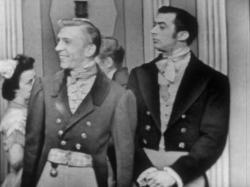 Mr. Bingley and Mr. Darcy at the ball |
|
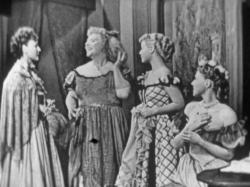 Bennet females preparing for the second ball |
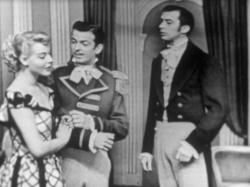 Lydia Bennet, George Wickham, suddenly meeting Mr. Darcy |
|
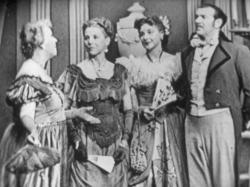 Mrs. Bennet, Miss Bingley, Mrs. Hurst and Mr. Hurst |
 Elizabeth with Uncle and Aunt Gardiner and the housekeeper at Pemberley |
|
| “Pride and Prejudice,” Philco Television Playhouse (University of Wisconsin, Wisconsin Historical Society) | ||
The fifties
Pride and Prejudice. Dir. Campbell Logan. Screenplay by Cedric Wallis. Perf. Daphne Slater, Peter Cushing. BBC, 1952. [Never recorded.]
Pride and Prejudice. Dir. Barbara Burnham. Screenplay by Cedric Wallis. Perf. Jane Downs, Alan Badel. BBC, 1958. [Lost.]
“Pride and Prejudice.” Philco Television Playhouse. Dir. Albert McCleery. Screenplay by Helene Hanff. Perf. Marcia Henderson, Anthony Dearden. NBC, 1956. [Lost.]
“Pride and Prejudice.” General Motors Presents (a.k.a. Encounter). Dir. Paul Almond. Screenplay by Lister Sinclair. Perf. Kay Hawtrey. Patrick Macnee. CBC, 1958. [Lost.]
The 1950s were without a doubt the heyday of Pride and Prejudice adaptations. If we include all short and long versions made in this decade across the world, there were no fewer than five adaptations (not counting other works by Jane Austen), half of the programs discussed here.
For starters, the BBC produced Pride and Prejudice for the second time, fourteen years after its first attempt. It was no longer a brief one hour rendition but for the first time a full series, six half-hour episodes, with a screenplay by Cedric Wallis. Elizabeth was portrayed by Daphne Slater, who seems to have had a talent for historical drama, as she later also played the leads in Jane Eyre (BBC, 1956) and Persuasion (BBC, 1960). Peter Cushing was Mr. Darcy; he was later to become well known through film and TV versions of Sherlock Holmes, Star Wars (1977), and the Hammer horror films. Another credit that seems in hindsight unexpected, in her TV debut as Lydia Bennet, is Prunella Scales—perhaps best known as Sybil Fawlty, Basil’s wife and the harpy of Fawlty Towers, and to Janeites as Miss Bates in the 1997 Emma directed by Diarmuid Lawrence (starring Kate Beckinsale). The series began on February 2, 1952, and was performed live. Jane Austen herself appears in the cast list as well, portrayed by Thea Holme. One can only assume that, as with the 1949 story, Austen’s character served as a narrator in order to facilitate the telling of the story, some parts of which must have been difficult to bring before the camera. The restrictions of live television are often quite evident in surviving TV shows from this era.5
Even though this 1952 version was recorded as a live broadcast, it was by now possible to keep programs by recording output on film, just as had been done with the 1949 version. But while the U.S. was the great pioneer of television, making such a copy was not yet standard practice in the U.K.; there appeared to be no use for it. All we have left today from the 1952 Pride and Prejudice are some publicity photos.
When the BBC wanted to show Pride and Prejudice again in 1958, a new cast performed the same script that had been used in 1952. This one started January 24, with Alan Badel as Mr. Darcy and Jane Downs as Elizabeth. Some changes were apparently made to the production of six years earlier: Jane Austen herself no longer appears in the credits. As before, it was serialized in six half-hour episodes.
This time the output of the live performance was recorded onto film. This innovation allowed the adaptation to be repeated and exported to Australia, where it was shown in December 1958. There was no official archive policy, however, and in the 1960s and 1970s it was thought that TV series, especially from the black-and-white era, had no lasting value. Equity, the actors’ union, prevented repeats, so for many programs there seemed to be no future use. And while film (unlike video tape) cannot be reused, it still needs to be stored. The BBC—and, to be fair, every other broadcaster, channel, and station worldwide—discarded a great many programs in the 1970s. In the case of the 1958 Pride and Prejudice, it appears that the film prints were discarded ten years later, possibly because the program had been superseded by a new rendition. Australia was required to return its copies of BBC programs (or forward them to another taker); it has been verified that the 1958 BBC version does not survive there either.
Unfortunately, even though there is a transcript of the pre-war broadcast, it has not been possible to locate screenplays for the two BBC efforts from the 1950s; the closest impression that we can get today is the Dutch version De vier dochters Bennet (1960–1961), which happens to have used a translation of the script written by Cedric Wallis for the BBC (Wels).6
In North America, Pride and Prejudice was on television twice during this decade, but, as before, in single episodes of anthology series. The first, on October 1, 1956, was season 2, episode 23 of NBC Matinee Theater. Quite possibly this broadcast was in color, although it was still a live performance. Marcia Henderson portrayed Elizabeth; Anthony Dearden, Darcy. Although there are no copies currently known to exist, the script is available from the New York Public Library.
This episode apparently makes NBC the only network apart from the BBC to have adapted the novel twice. The new take is unrelated to the 1949 production and approaches the story very differently. The dialogue has been modernized, striking a very different and more direct tone: e.g., Elizabeth declares of Darcy, “He wants taking down,” which is more or less what she will have succeeded in doing in the end. Because of this innovation, events can be told more quickly, allowing for more of the story to be presented. Jane’s illness at Netherfield is included; Mr. Collins and Lady Catherine both appear for their confrontations with Elizabeth. There is even time for the addition of some completely new material: Elizabeth becomes the first person to beat Darcy at chess. Wickham’s role, however, is still limited, as it was in 1949; he is merely mentioned as having eloped with Lydia.
In Canada the novel was adapted for General Motors Presents (a.k.a. General Motors Theatre) on December 21, 1958. It starred Kay Hawtrey as Elizabeth and as Mr. Darcy none other than Patrick Macnee (of later The Avengers fame). Kay Hawtrey was at the beginning of a long career of very diverse but mostly supporting roles; she retired about a decade ago. Currently no copies of the broadcast are known to exist; however, the script gives us an impression of what it might have looked like, and 44 photos of this production are known to exist as well. It should be remarked that the script contains one peculiarity: Mr. Bennet during the first act twice announces to his family the visit of a mystery guest, whom he each time reveals to be Mr. Collins. It seems rather unlikely that the performance would have reproduced that without any of the cast or crew experiencing déjà vu. We must accept that a script may not always be a completely accurate record of the final product as it went out.
The necessary contraction of the novel was effected by greatly reducing the movements of the main characters as well as their number, like the method used in 1938 but with different results. Although many familiar pieces of dialogue have been kept and the characters that remain are true to their characterizations, this version has compressed the action enormously, leaving for example only one ball, during which the two main characters have their battle of wits but do not dance with each other: it may have been too much of a technical challenge to stage that. Jane’s illness and stay at Netherfield, Elizabeth’s arrival there, and Darcy’s overheard slighting of Elizabeth at the ball are all noticeably missing. Nevertheless, given the unavoidable constraints in time and possibilities, the story has not fared too badly. Should the program ever turn up—it is not completely impossible—I expect that it might be quite enjoyable.
Pride and Prejudice: The Final Frontier
Also worthy of mention is an extant episode of the TV series Wagon Train, a western dealing with pioneers heading west. One episode from June 17, 1959, “The Steele Family,” tells the tale of a widow with four unmarried daughters. These four drive the wagon master crazy by distracting all the men. The two eldest, Faith and Hope, are sensible, but the youngest, Prudence, runs away with a lieutenant. Mr. Dashwood, the owner of the local silver mine, is initially wary of the girls’ trying to ensnare him, but when Faith initially rejects him, he admires her spirit. Strangely enough, it all turns out well. Hope marries his nephew and foreman, Clay Willis, and even Charity finds a husband among the trekkers. The plot is simplified and the end credits conveniently forgot to give credit to Jane Austen, but it is obvious that this story is Pride and Prejudice transported to the wild west. While strictly speaking not a faithful adaptation of the novel, it still contributes to the choir of different versions of the 1950s.
The sixties
Pride and Prejudice. Dir. Joan Craft. Screenplay by Nemone Lethbridge. Perf.Celia Bannerman, Lewis Fiander. BBC, 1967. [Exists.]
The 1960s bring us to the last black and white series, produced in 1967, once again by the BBC. This fourth BBC series first aired on September 10, with a new screenplay by Nemone Lethbridge.
Television was no longer broadcast primarily live, and this series did not have some of the limitations of earlier productions; it has, for example, plenty of scenes filmed on location (so-called “inserts”).7 Consequently the 1967 version may have been rather different from its predecessors, although the biggest difference by far must simply be the fact that this one is extant. All of the episodes still exist; although they have never been repeated or released, they can be seen at the British Film Institute in London. Surprisingly, although it’s half a century old, with six half-hour episodes the pace is a bit faster than what we’re used to with the BBC color series of 1980 and 1995.
In 1967 it was Mary Bennet’s turn to be eliminated from the story. Otherwise, it is a reasonably close adaptation,8 certainly when compared to the other efforts mentioned above, save perhaps for the aftermath of Lydia’s elopement, which is quickly rushed through at the start of the last episode. There are many moments directly from the book and in Jane Austen’s own words, but a couple of scenes noticeably diverge from the novel. It is, for example, spelled out for us that the Bingleys amount to nouveau riche; Wickham shows up at Netherfield, only to have Darcy eject him; and at Pemberley, Mr. Bingley directly confronts his sister and Darcy on their hiding Jane’s presence in London from him. It is telling that almost all of these alterations result in more openly visible exchanges and clashes, as opposed to the more careful and controlled way in which any friction is usually depicted in the novel.
One reason for these changes may be that the genteel conventions in place around 1800—when even simply introducing oneself, as Mr. Collins does to Mr. Darcy, was a serious faux pas—are sometimes too subtle and too far away for us; changes may have been introduced in an effort to better engage a modern audience, and to liven things up by enhancing the existing conflicts. The novel is certainly not without passionate confrontations—e.g., Darcy’s first proposal and Lady Catherine’s visit to Longbourn, which are both met with Eliza’s sharp rebuttal—but for six episodes more occasions were needed for emotions to run high. The screenwriter, Mrs. Nemone Lethbridge, speaking on the phone in August 2018, did not contradict this explanation.
The 1967 Pride and Prejudice is the only production (apart from 1949) that allows us to say anything about the music. It uses music from the correct time period by the lesser known composer Johann Nepomuk Hummel (1778–1837), namely Opus 17.1, Concerto for Violin and Piano (“Double Concerto”), for its main theme as well as for Lizzy’s cross-country walk early in episode 2.
First conclusions
After 1967, there was less interest in revisiting the novel. The 1970s saw none at all, although there was an abandoned movie project in the middle of the decade (Looser 136–40). The treatments are more widely spaced, with the first color version appearing in early 1980; after the success of the 1995 version, there has been no straightforward attempt for television.
Pride and Prejudice was at its most popular in the 1950s. Among many other literary adaptations of that time, it was usually the first Austen to be televised. The results were varied, providing an interesting smorgasbord of omissions and additions, bringing the viewers both many changes and many original details. Sadly, this mixed palette is permanently hidden from our sight because nearly all of these versions are now lost. Regrettably, we have very little information about either of the two BBC series from the 1950s.
What we can say is that between 1938 and today, the English-language TV shows based on Jane Austen’s Pride and Prejudice have steadily been getting longer. This development may be somewhat surprising: one might have expected television from the past to move more slowly while staying more orthodox in its fidelity to the source. But even the BBC, the only broadcaster to adapt Pride and Prejudice frequently, only used six half-hour episodes for its three attempts between 1952 and 1967—hence the customary removal of either Mary or Kitty. The anthology episodes never showed either sister. These one-parters were, of course, even more pressed for time, which each made up in a different way: by necessity they sometimes reduced (or even practically eliminated) the parts of Mr. Wickham and Mr. Collins. Needless to say, this reduction has an impact: it affects the remaining characters’ motivations and significantly simplifies the plot—though the 1938 broadcast seems to have managed the reduction surprisingly well. The foreign language versions, on the other hand, used more time to tell the story: Orgoglio e pregiudizio, if now-missing footage is included in the count, is the lengthiest of all productions to date, with the long runtime translating principally to both additional material and a significantly slower pace.9
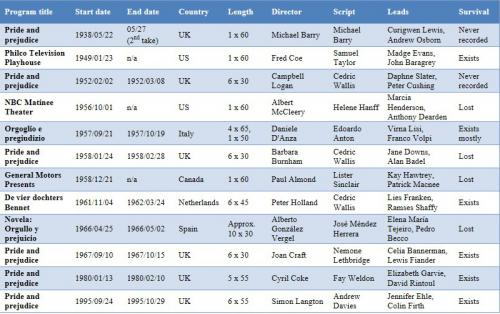
Specifics of all known televised versions worldwide of Jane Austen’s “Pride & Prejudice,” 1938-1995.
Another unexpected trend that follows from the steadily increasing runtime is that between 1938 and today, the television adaptations have become more authentic. Freedom from technical limitations of the studio and the longer runtime are only part of the explanation. Sometimes the changes conform to one particular trend: moments of tension and confrontation (comic ones excluded) have been magnified or added. This change is different and slightly further reaching than merely exaggerating some of the characters’ peculiarities (something that may occasionally happen as well). In the BBC’s 1967 series, for example, clashes between the characters are the only events that are repeatedly altered and made sharper—leaving aside, of course, many parts of the novel that simply had to be omitted entirely. It would appear, then, that the moments of friction in the story in the past were presented much more explicitly and tension was generally heightened. A similar tendency can be seen in the surviving Dutch and Italian series mentioned earlier; the Italian series in particular has added several completely new confrontations and even opens with Darcy and Wickham picking up swords to fight a duel.
Two exceptions that, in general, essentially confirm this trend are Darcy’s first proposal and Lady Catherine’s visit to Longbourn: both exchanges are already at the right temperature; thus, none of the surviving versions had any reason to heat up these meetings further. Only the 1949 broadcast omits the latter meeting. But especially the serializations (insofar as we can access them), with their longer runtimes, seem to have felt a need to enhance other, colder conflicts by making them more violent or heated. In contrast to the anthology series, they required more such scenes, ideally at least one emotional discharge for every episode.
Looking beyond 1967, the question arises why the BBC series from 1980 and especially 1995 chose not to make this particular kind of change (although they both made some alterations). It may still be technology that’s behind it. The 1995 series especially has one structural advantage over the others: in the words of its creators, “Freedom.” Andrew Davies and Sue Birtwistle had a visual agenda and, according to their intentions, shot their version entirely on film and on location (Birtwistle and Conklin passim). Consequently, they were able to deliver spacious and very attractive settings, much more so than their predecessors, since even the 1980 version was still partially studio-bound. In this way, the 1995 Pride and Prejudice managed to add an entirely new, purely visual layer to the story, and those enchanting pictures could serve as a sort of back-up for viewers who weren’t that attuned to the style of Jane Austen’s prose. Previous versions without that luxury had to keep their focus much more on the narrative; emotions needed to be readily visible for the modern audience. This need explains why in the older programs the carefully controlled verbal fights of Jane Austen’s 1800s were invariably “upgraded” to more outspoken exchanges whenever personalities clashed.
Epilogue: The fate of the shows
Will any of the lost shows ever be seen again? The chances are not good. Just like Mr. Darcy’s good opinion, an episode, once lost, is most likely lost forever. A number of missing episodes have been recovered on 16mm film from foreign TV stations and private collectors in the last thirty years, but the 1950s are a long time ago, and, in the general search, the obvious places where copies might have ended up have all been checked. The first two BBC versions were never recorded in the first place; we should not entertain the hope of ever seeing Peter Cushing as Mr. Darcy, let alone the program produced before World War II. The 1949 Philco Playhouse episode is a lucky exception. The other North American versions might still stand a chance of surprise recovery. The U.S. was ahead of the BBC when it came to recording output. Shows often ran in syndication and across the continent, therefore requiring several copies. Keeping copies is, of course, a different thing; the lack of an archiving policy is the problem. But other installments of these anthology series are known to exist. The University of California, Los Angeles for example does have a copy of NBC Matinee Theater’s Jane Eyre from 1957, also with Patrick Macnee. Occasionally similar episodes turn up for sale from film collectors.10
As for home recordings, primitive video systems first appeared only in 1967, and even then very few people could afford them, so that option is unlikely. But sometimes people recorded the sound from the TV set onto an audio tape reel. Audio reel recorders were much more widespread than early home video equipment. Soundtracks from missing TV shows turn up from time to time, often without people realizing that they may still be useful. The General Motors episode, with its many photographs, could be reconstructed as a slideshow if its audio were one day found.11
Finally, I encourage everyone who still has old sound recordings from fifties or sixties television, handed down perhaps by parents or grandparents, to contact a TV archive or other institution (in the U.S.: UCLA, the Library of Congress, or the Paley Center; in the U.K.: the British Film Institute, the BBC, or Kaleidoscope). Alternatively, feel free to contact the author for advice.
ACKNOWLEDGMENT
I am most grateful to Mrs. Nemone Lethbridge for her comments.
NOTES
1The surviving Italian and Dutch versions may be analyzed in separate articles; a now-lost Spanish adaptation in ten parts from 1966 has been discussed by Mari Carmen Romero Sánchez.
2It is not impossible that other versions from days gone by might exist in a low-profile environment.
3In December 1917, Moving Picture World casually mentioned a British Pride and Prejudice as one of several upcoming treats soon to be completed by the Ideal Company, but, as sometimes happens in film and television, nothing was ever heard of it again; there is no evidence that it was ever made.
4The movie, originally black and white, has also at one point been colorized. Given that it’s already taking liberties with the novel, some may find its color version more in keeping with its light and cheerful tone.
5In the 1949 U.S. and Dutch 1961 versions, we can still see how actors keep going even if someone has made a mistake or forgotten a line and (in the latter) how some of the supporting cast sometimes continues a scene with less-than-relevant dialogue to allow the lead actors time to change and move to the next set.
6On a side note, Wallis, in between the two BBC productions of his scenario, had also published a comical play called The Heiress of Rosings, a continuation of Pride and Prejudice, focusing on a romance for Anne de Bourgh. In the U.K. it only made it to the radio (July 2, 1956), but in the Netherlands it was inexplicably televised in 1957, long before Pride and Prejudice ever was. It does not survive.
7It is consequently somewhat amusing to read the assertion that the 1980 five-parter would have been held back by technical limitations (Belton 175); the scene, for example, where Mr. Collins is planting bulrushes by (or in) the lake in his special hat surely contradicts this claim.
8What constitutes “faithful” is of course open for debate, but by it I mean that in a general sense the order of events is unaltered; that at times some things have been omitted but that no or only very few new scenes or themes have been added; and that the characters and their motivations have not significantly changed.
9Its third episode is acknowledged to be missing the last twenty minutes, but, in my opinion, the same applies to the first episode, only less obviously so for modern eyes. It covers chapter 10, albeit rather freely, but there is no material from chapter 11; and although the slight jump forward in the story may not be unusual today, it is at odds with the otherwise slow pace of this 1957 adaptation. The teaser that now opens episode two may simply be a leftover from episode one, representing some material from a lost reel that could still be salvaged.
10Some collectors can be reluctant to lend episodes back to the same organization that once discarded them, but the generous thing to do is to find a way to share them with others, as they were meant to be seen by all.
11Perhaps most famously the BBC’s missing episodes of Doctor Who have been reconstructed in this way, using photos and off-air audio recorded at home by fans on reel-to-reel audio decks.
